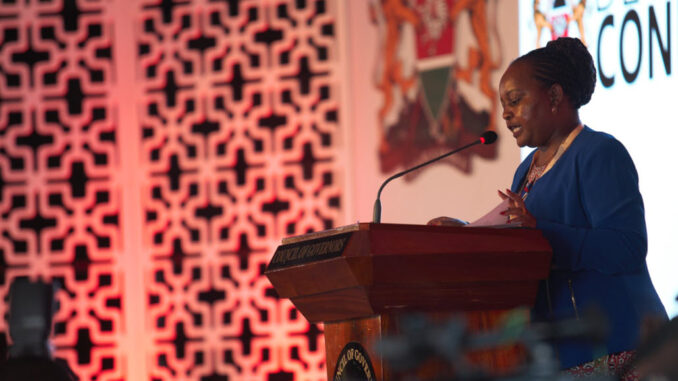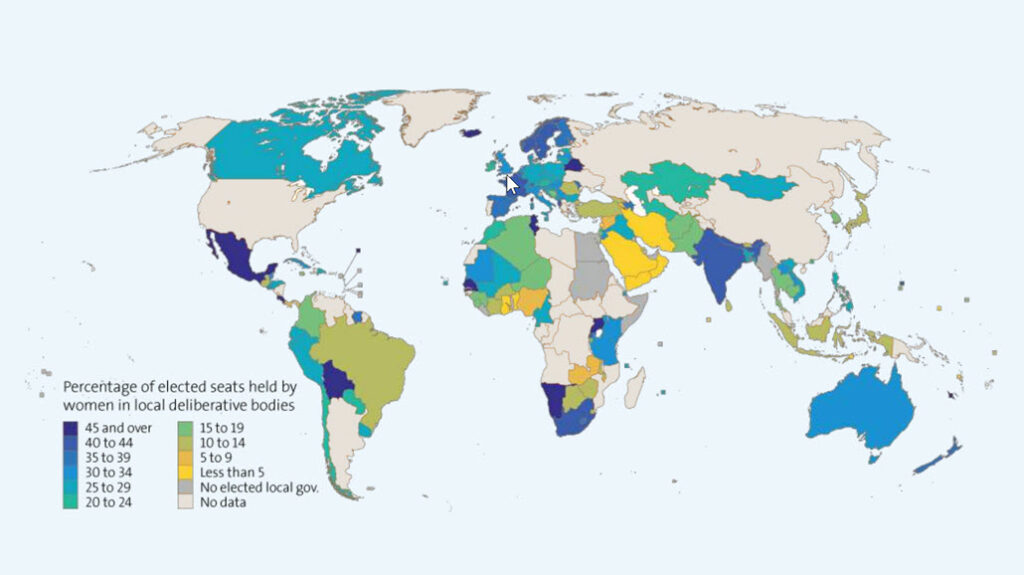
Subnational governments play a key role in achieving inclusive governance and an inclusive public sector. Not only do local governments form the government level closest to the people, and therefore have the greatest potential for inclusive participation, but local governments provide many of the basic public services that matter directly in the daily lives of people. As such, achieving inclusive local governance is especially relevant for the empowerment of women, youth, and other groups that may have had more limited access to public-decision-making in the past. The legendary U.S. Supreme Court Justice, Ruth Bader-Ginsberg recognized the importance of women’s representation when she noted that “[w]omen belong in all places where decisions are being made”.
A recent working paper by UN Women presents a data-based analysis of women’s representation in local governments around the world, use of legislated quotas and types of electoral systems in local elections, contributing to a more comprehensive view of women’s political participation and a shift in the global narrative from national to local decision-making power, a less known but critical level of governance. Women’s rights to equal political participation at all levels of government are recognized in international normative frameworks, emphasized in the Beijing Declaration and Platform for Action, and endorsed, decades later, in the 2030 Agenda for Sustainable Development Goals (SDGs).
The importance of equal political participation at all levels of government is clear in the wording of SDG target 5.5 – “ensure women’s full and effective participation and equal opportunities for leadership at all levels of decision-making in political, economic and public life” – and the choice of indicators for monitoring progress in achieving this target.
Two indicators on women’s representation in decision-making in political life are included in monitoring this target: SDG indicator 5.5.1a on women’s representation in parliaments – previously included in the Millennium Development Goal (MDG) monitoring framework– and SDG indicator 5.5.1b, a new indicator on women’s representation in local government.
The new SDG indicator, focused on local decision-making power, expands research and global data on women’s political representation beyond national legislatures. The past three decades have focused on parliaments as countries’ highest legislative bodies with powers to craft and change national legislation and oversee national budgets. The relatively few women and men members of parliaments are counted and captured globally in SDG indicator 5.5.1a, on a regular basis, by the Inter-Parliamentary Union (IPU). Year after year, the numbers collected by IPU tell the story of the considerable underrepresentation of women in legislative bodies and the slow and uneven progress in improving their participation over time.
The story of women’s representation among the millions of local government members, however, remains largely untold.
The story of women’s representation among the millions of local government members, however, remains largely untold. Despite some country case studies and regional initiatives, global data and research on this level of government has been scant, resulting in a major knowledge gap. The addition of the indicator 5.5.1b to the global SDG monitoring framework recognizes the importance of a whole-of-government approach and of women’s voices and leadership at the local level in achieving the SDGs.
Local government is the result of the decentralization of legislative, executive and administrative powers from national to local levels for the purpose of improving governance on local matters and enabling a more direct and inclusive participation of different population groups in local decision-making. In this regard, SDG indicator 5.5.1b takes note of a much more numerous and diverse group of women, and the realization of their rights, as well as their roles as local leaders in ensuring sustainable development. Indeed, research indicates that women in local decision-making positions redefine local priorities by being more inclusive, prioritizing family-friendly policies and measures, and, in some contexts, by contributing to increased gender equality in terms of income, employment and parental leave.
The recent working paper by UN Women presents global data and data-based analysis on women’s representation in local government by UN Women as the sole custodian agency for SDG indicator 5.5.1b. Nominated as such in 2016, UN Women finalized its methodology in 2017 and started compiling data from countries in 2018. As per its methodology, the indicator is measured as the proportion of elected seats held by women in deliberative bodies of local government such as local councils or assemblies. The data used are official data on elections results produced by electoral management bodies (EMBs), reported by national statistical offices (NSOs), and compiled by UN Women with the support of UN regional commissions. Unless otherwise stated, this paper employs data on the most recent local election results as of 1 January 2020, available for 133 countries and areas (see map; data available at localgov.unwomen.org).
The analysis indicates that in many countries, women’s representation in local deliberative bodies is higher than in parliament, but still not on equal terms with men. Indeed, very few countries have reached gender balance in local decision-making bodies; in the majority of countries, women’s under-representation is severe. Legislated gender quotas have a significant positive impact on women’s representation in local government, particularly in countries in Africa and Asia, and can disrupt the cycle of male-dominated political leadership. Electoral systems based on proportional representation and mixed systems are also associated with higher representation of women at the local level; however, in the absence of quotas, their impact is less significant.
Finally, the paper discusses remaining data gaps on women’s political participation at local level, including data disaggregation issues, underused electoral data, and the need for new data collection tools to capture women’s full and effective participation in local government.
Access the full report on the website of UN Women:
Photo: Governor Anne Waiguru, deputy chair for the Council of Governors and Kirinyaga County Governor addresses the 2018 Devolution Conference in Kakamega County. Photo credit: Flickr/Mwangi Kirubi/USAID.






